The headline inflation of prices in Davao de Oro Province increased further to 10.8 percent in June 2022 from 9.0 percent in May 2022. This is the highest recorded inflation of prices since January 2019. Inflation in June 2021 was lower at 2.1 percent. The average inflation for the first six months of the year stood at 7.1 percent. (see Table 1 and Figure 1)
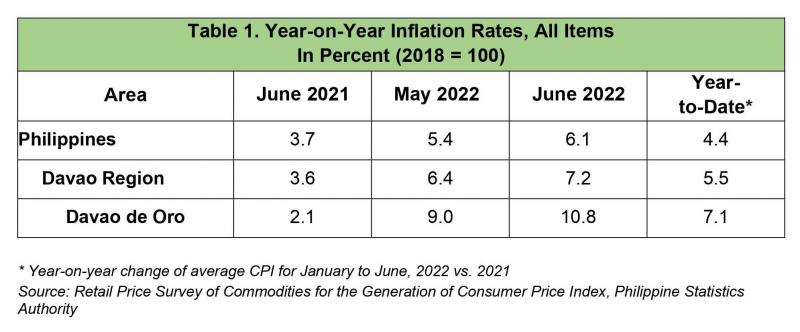
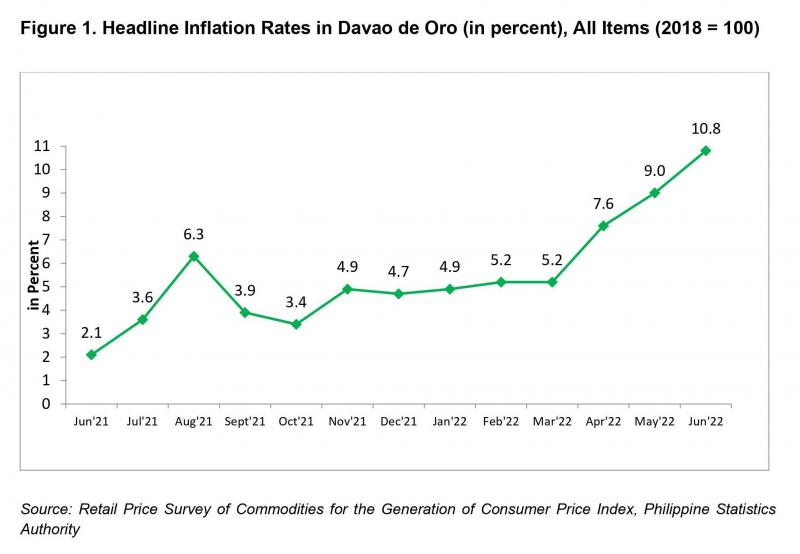
The increase in the province’s inflation was mainly brought about by the higher annual increase in the index for transport at 21.2 percent; housing, water, electricity, gas, and other fuels at 17.6 percent; and alcoholic beverages and tobacco at 11.1 percent. (see Table 2)
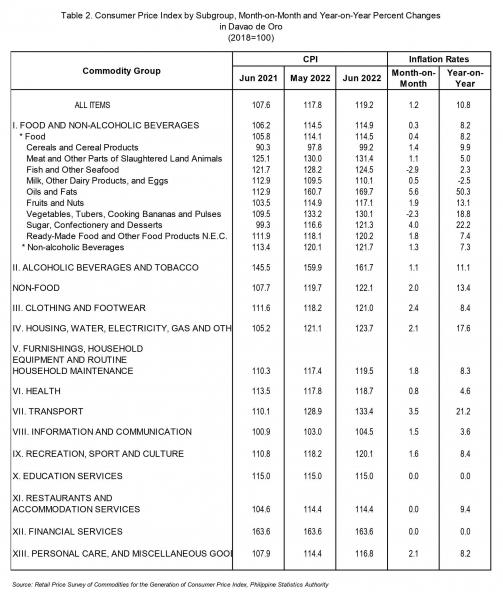
Also contributing to the uptrend in the overall inflation during the period were the higher annual increments in the indices of the following commodity groups as compared with their previous month’s inflation rates:
-
Restaurants and Accommodation Services, 9.4 percent
-
Recreation, Sport and Culture, 8.4 percent;
-
Clothing and footwear, 8.4 percent;
-
Furnishings, Household, Equipment and Routine, 8.3 percent;
-
Food and Non-Alcoholic Beverages, 8.2 percent;
-
Personal Care, and Miscellaneous Goods and Services, 8.2 percent; and
-
Health, 4.6 percent.
Meanwhile, annual upticks slowed down in the information and communication index at 3.6 percent. The rest of the commodity groups had zero percent annual growths.
For food index, it increased further by 8.2 percent in June 2022, from 7.1 percent in the previous month. In June 2021, food index was lower by 1.9 percent. The annual growth rate of the oils and fats index went up to 50.3 percent during the month, from 45.2 percent in the previous month. In addition, double-digit growth rate was observed in the corn index with an inflation rate at 34.4 percent; sugar, confectionery and desserts at 22.2 percent; vegetables, tubers, plantains, cooking bananas and pulses at 18.8 percent; fruit and nuts at 13.1 percent; and flour, bread and other bakery products, pasta products, and other cereals, 10.2 percent. (see Table 3).
The following food groups exhibited higher annual increments during the month:
-
Cereals and Cereal Products, 9.9 percent;
-
Ready-made food and other food products n.e.c., 7.4 percent;
-
Meat and other parts of slaughtered land animals, 5.0 percent;
-
Rice; 2.4 percent;
-
Fish and other seafood, 2.3 percent; and
-
Milk, other dairy products and eggs, -2.5 percent.
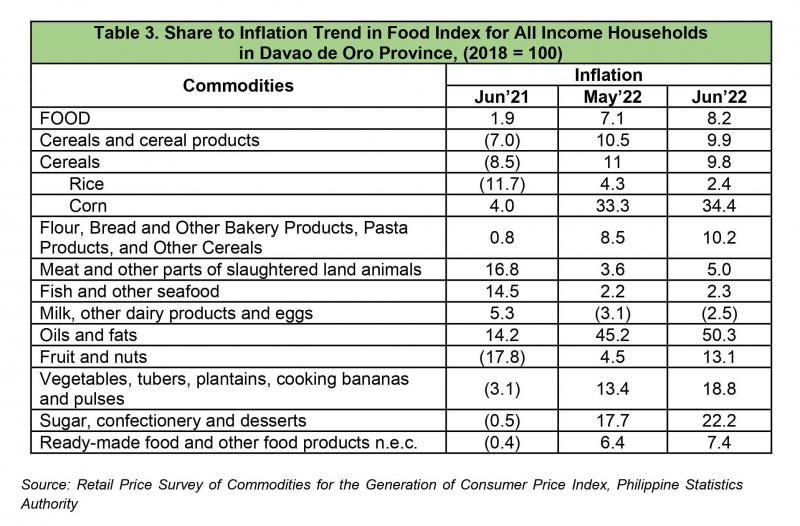
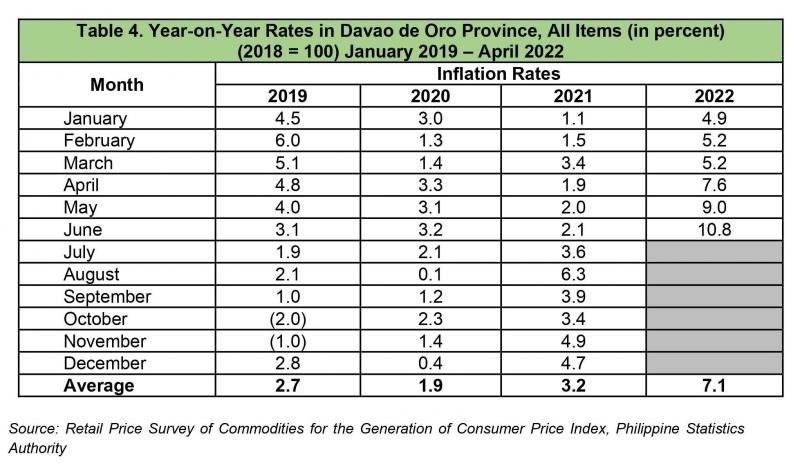
Consequently, the Purchasing Power of Peso (PPP) based on year 2018 in Davao de Oro Province is equivalent to 0.84 in June 2022. (see Figure 2)
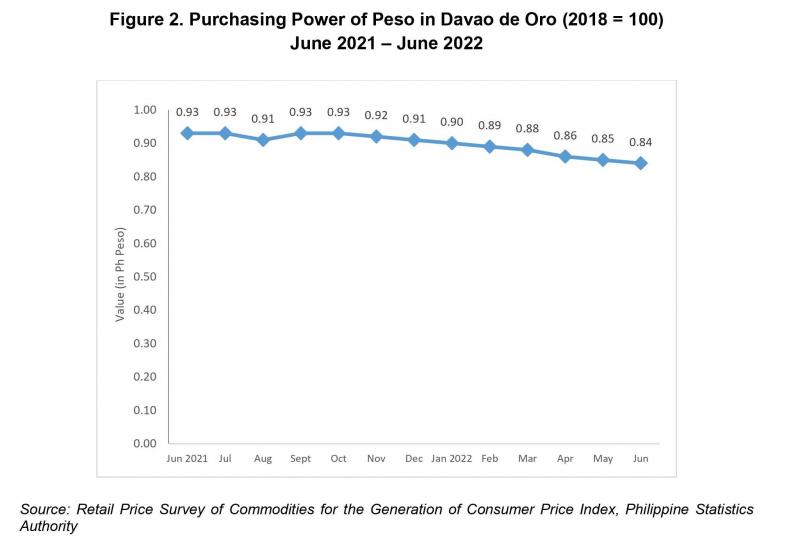

Price – is the amount or value paid in exchange for the commodity or a service rendered.
Retail/Consumer Price – refers to the price at which a commodity is sold in small quantities for consumption.
Market Basket– a term used to refer to a sample of goods and services that are commonly purchased and bought by an average Filipino household.
Consumer Price Index (CPI) – it is an indicator of the change in the average retail prices of a fixed basket of goods and services commonly purchased by an average Filipino household. It shows how much on the average, prices of goods and services have increased or decreased from a particular reference period known as base year.
Inflation Rate – is an indicator derived from the CPI. It refers to the annual rate of change or the year-on-year change of the CPI expressed in percent. Inflation is interpreted in terms of declining purchasing power of money.
Weight– a value attached to a commodity or group of commodities depending on the magnitude of its contribution to the index.
Base Period – a reference date at which the index is equal to 100. Base year is 2018.
Index Methodology– a Laspeyre’s formula: fixed base year and weights.
Purchasing Power of the Peso (PPP) – the measure of how much the peso in the base period is worth in the current period.
Percentage Change– is a simple mathematical concept that represents the degree of change over time. It is used for many purposes in finance, often to represent the price change of a security.
Headline Inflation– measures changes in the cost of living based on movements in the prices of a specified basket of major commodities. It refers to the annual rate of change or the year-on-year change in the Consumer Price Index (CPI).
